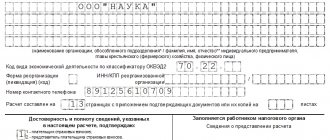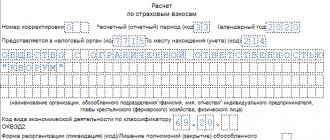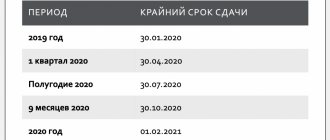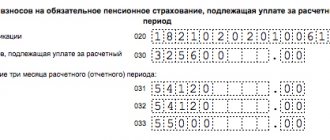ERSV deadline for 2021 and current form
Absolutely all employers are required to submit insurance premium calculations (ERSV):
- Companies, their branches and separate divisions (if these separate divisions independently calculate and pay contributions) “surrender” to the Federal Tax Service at the place of registration or business (clause 7 of Article 431 of the Tax Code of the Russian Federation).
- Individual entrepreneurs - to the inspectorate at the place of registration (registration).
If there were no accruals in the reporting period (from January to December 2021), you are required to submit a zero calculation by filling out the required sections and applications. This will allow tax authorities to distinguish those organizations that did not have accruals from those that forgot to submit calculations (for entrepreneurs, such an obligation is not established by law).
The deadline for submitting the DAM is set by the Tax Code of the Russian Federation on the 30th day of the month following the reporting quarter. The results of 2021 must be reported no later than January 30, 2021.
If the DAM for 2021 is submitted 10 days later than the deadline, tax authorities have the right to block the current account (clause 3.2 of Article 76 of the Tax Code of the Russian Federation). The same trouble threatens the policyholder who submitted the calculation on time, but with erroneous information: the tax authorities will not accept the report, and it will be considered not submitted.
The RSV form has not changed. The calculation for the 4th quarter of 2021 is still submitted in the form approved. By order of the Federal Tax Service of October 10, 2016 N ММВ-7/11/551.
The report for the 4th quarter of 2021 can be submitted on paper by policyholders whose payroll for 2021 does not exceed 24 employees inclusive. All employers with a large payroll are required to report electronically via telecommunications channels. For violation of this requirement, the policyholder will face a fine for the incorrect method of submitting the calculation - 200 rubles. (Article 119.1 of the Tax Code of the Russian Federation).
How to fill out a blank insurance premium calculation
The norms of Russian tax legislation do not provide specific explanations about the need to submit a zero calculation for insurance premiums to the Federal Tax Service (instructions for filling out are reflected in Order No. ММВ-7-11/551). Thus, when answering the question of how to correctly fill out the calculation of insurance premiums, you should refer to the order that approved it. However, even if the company did not operate during the period and income was not paid to staff, filling out a new calculation for insurance premiums is a common practice.
Calculation of insurance premiums 2021 zero example
Registration of ERSV for 2021
The report consists of 3 sections and 24 sheets, which display information about all insurance premiums, except for “accidental” ones. But you only need to fill out those that are mandatory and for which you have indicators.
Let's consider who should fill out which sheets when preparing reports for the 4th quarter of 2021.
| Sheet | Is it necessary to fill out | Who fills it out |
| Title | Yes | All policyholders |
| Sheet “Information about an individual who is not an individual entrepreneur” | No | Only individuals who are not registered as entrepreneurs |
| Section 1 | Yes | All |
| Annex 1 | Yes | Subsections 1.1 and 1.2 - filled out by all policyholders, Subsections 1.3, 1.3.1., 1.3.2, 1.4 are completed only if there are payments of contributions for additional tariffs |
| Appendix 2 | Yes | All employers indicate information about insurance premiums in case of temporary disability and maternity |
| Annexes 3 and 4 | No | Fill out only those employers who paid sick leave benefits in the reporting period |
| Appendix 5 | No | Filled out by IT firms that have the right to apply reduced tariffs |
| Appendix 6 | No | They are drawn up by simplifiers who have the right to apply reduced tariffs in accordance with paragraphs. 5 p. 1 art. 427 Tax Code of the Russian Federation |
| Appendix 7 | No | NPOs engaged in activities named in paragraphs. 7 clause 1 art. 427 of the Tax Code of the Russian Federation, which allows you to pay contributions at reduced rates |
| Appendix 8 | No | Businessmen apply for a patent, with the exception of those who work in catering, retail or rent out real estate |
| Appendix 9 | No | Designed for those employers who pay income to foreigners and/or persons temporarily staying in the Russian Federation |
| Appendix 10 | No | Issued only in relation to payments to students working in student teams under a GPC or labor agreement |
| Section 2 and Appendix 1 | No | Only heads of peasant farms in relation to contributions for themselves and members of the farm |
| Section 3 | Yes | Employers record pers. information on all hired persons |
FILLING SEQUENCE
Start with the title page. Then form Section. 3 for each employee who was registered with you in the 4th quarter. After this, fill out the Appendices to Section. 1. And last but not least, Section itself. 1.
Step-by-step instructions for filling out insurance premium calculations
When answering the question of which sections to fill out in the calculation of insurance premiums, we note that the mandatory elements for calculating insurance premiums include:
- 1st Section, covering general information about contributions to be transferred;
- Section 1, Appendix 1, Subsection 1.1 – information on pension contributions;
- Section 1, Appendix 2, Subsection 1.2 – data on health insurance;
- Section 1, Appendix 2 – information on social insurance contributions made;
- Section 3 – personalized accounting data for each employee of the company.
An example of filling out the calculation of insurance premiums can be downloaded from the provided link:
(Sample) Calculation of insurance premiums 2018
The authorized body of the Federal Tax Service defined the procedure for filling out the declaration and calculating insurance premiums in the order that approved the reporting form in 2016.
Thus, filling out the calculation of insurance premiums - the example discussed above - comes down to reflecting information about employees officially employed by the policyholder:
- Completing section 1 of the calculation of insurance premiums involves disclosing all information about contributions to medical, pension and social insurance;
- Completing section 2 of the calculation of insurance premiums does not fall into the category of mandatory sections, since it is used only for agricultural companies;
- Many questions arise about how to fill out section 3 of the calculation of insurance premiums. Due to the fact that this element of the report is used to clarify information about each employee, filling out section 3 of the calculation of insurance premiums must reflect personalized (personal) data for each insured person, affecting pension insurance issues.
Among the questions that policyholders most often ask about the procedure for filling out the calculation of insurance premiums is the mechanism for filling out line 090 of the calculation of insurance premiums. Information in this line is entered only in a positive value, regardless of whether the amount payable to the treasury or the excess amount is reflected.
Filling out the calculation of insurance premiums, Appendix 2, relating to the first section, is mandatory for all policyholders. This element of the tax report should reflect information about expenses for sick leave and maternity expenses. Accordingly, in this case, you should pay attention to the example of filling out the calculation of insurance premiums with sick leave presented above.
Title page
The main fields of the title include “standard” information about the policyholder:
- Name.
- INN/KPP.
Separate divisions that independently pay income to employees indicate their checkpoint.
- Correction number (001, 002, etc.). For the initial calculation, enter 000 in this field.
- The reporting period code is 33 for a 9-month report.
- Federal Tax Service code where the calculation is submitted.
- In the “location” field, enter the code corresponding to where the payment is being submitted. Our table will help with this:
- OKVED code.
- Full name of the person signing the report and date of signing.
- Leave the field “to be filled in by a tax authority employee” blank.
Calculation of insurance premiums 2021 (sample) and the procedure for submitting it to the Federal Tax Service
It is important for policyholders not only to prepare a calculation of insurance premiums for 2021 (and a sample can be found using the links provided above), but also to submit it to the authorized tax authorities in a timely manner.
Companies and entrepreneurs with no more than 25 employees are allowed to submit a 2021 pension report “Calculation of insurance contributions” - a sample in paper format. As for larger insurers, only an electronic system for transmitting a single calculation of insurance premiums 2021 is provided for them (the example was discussed above).
The sample for completing the calculation of insurance premiums 2021 belongs to the category of quarterly tax reports. In this regard, it is necessary to submit an example of filling out a single calculation for insurance premiums before the 30th day of the month following the end of the reporting quarter.
The instructions for filling out the calculation of insurance premiums for 2018 assume that the receiving body of the tax report is the territorial branch of the Federal Tax Service in which the organization is registered.
Personalized information – section 3 of the ERSV for 2021
Complete section 3 separately for each employee. Please specify:
- in field 040 – a serial number that you define yourself. This can be either the number of personalized information in order (1, 2, 3, etc.) or the employee’s personnel number (Letter of the Federal Tax Service dated January 10, 2017 N BS-4-11/);
- in field 050 – the date of payment;
- in line 120 - for a Russian employee the code is “643”, for a foreigner - the code of his country from OKSM;
- in line 140 - code of the type of document identifying the employee. If it is a Russian passport, write “21”.
The category code of the insured person (column 200) for citizens of the Russian Federation is “NR”. Codes for foreigners: temporarily staying - VPNR, temporarily residing - VZHNR. If you pay contributions at reduced rates on the simplified tax system, the codes will be different: citizens of the Russian Federation - PNEED, temporarily staying foreigners - VPED, temporarily residing foreigners - VZhED.
In columns 210 - 250, show payments to the employee and accrued contributions to compulsory pension insurance from a base not exceeding the limit for the 4th quarter of 2018 - monthly and in total.
If payments were not accrued to the employee in the 4th quarter of 2021, then do not fill out subsection 3.2 (Letter of the Ministry of Finance dated September 21, 2017 No. 03-15-06/61030).
Example:
Payments to Potapov, a citizen of the Russian Federation, and contributions accrued from them to the compulsory pension insurance for the 4th quarter of 2021.
| Index | October | november | December | 4th quarter |
| All payments, rub. | 28 000 | 28 181,45 | 28 000 | 84 181,45 |
| Non-taxable payments, rub. | – | 4 602,90 | – | 4 602,90 |
| Contribution base, rub. | 28 000 | 23 578,55 | 28 000 | 79 578,55 |
| Contributions to community pension insurance, rub. | 6 160 | 5 187,28 | 6 160 | 17 507,28 |
A sample of section 3 as part of the DAM for the 4th quarter of 2021 will look like this:
Sample calculation of insurance premiums in 2018: fines for late submission
In the event that the completion of the calculation of insurance premiums in 2018 and its submission to the tax authorities were not completed on time, the policyholders are obligated to pay the amount of fines established by the tax authorities.
The rules for filling out the calculation of insurance premiums 2021 determine that for each full (or partial) month of delay, the amount of penalties is 5% of the amount of insurance premiums not transferred to the budget. If the calculation of insurance premiums (in 2021, the example will be similar to the sample discussed above) was not submitted on time, but the contributions were transferred in full to the tax control authorities, a fine of one thousand rubles is provided for failure to submit a sample of filling out a new calculation of insurance premiums.
The Federal Tax Service also establishes the possibility of accruing penalties if the payment of insurance premiums was made in violation of the deadlines established by law.
Summarizing the information presented above, we note that the question of how to fill out a new calculation for insurance premiums arises in almost every company acting as an employer. Accordingly, to answer it, you will need to refer to the Order of the Federal Tax Service, which approved the unified calculation.
Similar articles
- Calculation of insurance premiums 2021 sign of payments
- Calculation of insurance premiums 2021 form
- Unified calculation of insurance premiums in 2021 (example)
- Checking the calculation of insurance premiums 2018
- Calculation of insurance premiums in 2021 is zero
Expenses for payment of benefits – Appendix 3 to Section 1
In Appendix 3, reflect only benefits from the Social Insurance Fund accrued in 2021. The date of payment of the benefit and the period for which it was accrued do not matter. For example, reflect a benefit accrued at the end of December and paid in January 2021 in the calculation for 2021. Reflect the sick leave benefit, which is open in December and closed in January, only in the calculation for the 1st quarter of 2021 (Letter Federal Tax Service dated June 14, 2018 N BS-4-11/11512).
Do not indicate benefits at the expense of the employer for the first three days of the employee’s illness in Appendix 3.
Enter all data on a cumulative basis from the beginning of 2021 to December 31 (clauses 12.2 – 12.4 of the Procedure for filling out the calculation).
In column 1, indicate on lines 010 – 031, 090 the number of cases for which benefits were accrued. For example, in line 010 - the number of sick days, and in line 030 - maternity leave. On lines 060 – 062, indicate the number of employees to whom benefits were accrued (clause 12.2 of the Procedure for filling out the calculation).
In column 2, reflect (clause 12.3 of the Procedure for filling out the calculation):
- in lines 010 – 031 and 070 – the number of days for which benefits were accrued at the expense of the Social Insurance Fund;
- in lines 060 – 062 – the number of monthly child care benefits. For example, if you paid benefits to two employees throughout the year, enter 24 in line 060;
- in lines 040, 050 and 090 - the number of benefits.
Example:
For 2021 the organization:
- paid for 3 sick days. At the expense of the Social Insurance Fund, 15 days were paid, the amount was 22,902.90 rubles;
- awarded one employee an allowance for caring for her first child for October, November, December, 7,179 rubles each. The amount of benefits for 3 months amounted to 21,537.00 rubles.
The total amount of benefits accrued is RUB 44,439.90. (RUB 22,902.90 + RUB 21,537.00).
Filling out the ERSV using an example
Saturn LLC is engaged in the production of furniture (OKVED code 31.02). The company has three employees in the first quarter of 2021. For the first 3 months of the year, none of the employees were sick (there were no payments for sick leave) and no one received other amounts of insurance coverage. Saturn LLC does not have reduced tariffs. All employees received a salary, the amounts of which are used to calculate insurance premiums at the following rates:
- 22% - for compulsory pension insurance (MPI) and in the amount of 10% in excess of the established maximum value of the base for calculating contributions (we agree that for our example there is no such excess);
- 5.1% - for compulsory health insurance (CHI);
- 2.9% - for compulsory social insurance (OSS).
Also see: Exceeding the 2021 Premium Base.
Using the example of Saturn LLC, we will begin the calculation of contributions with the title page. Then we will deal with the personalized information from Section 3. After this, we will create Section 1 with summary data on the company’s obligations for insurance premiums.
Calculation of contributions for compulsory health insurance and compulsory health insurance – subsections 1.1 – 1.2 of Appendix 1 to section. 1
Basic tariff codes (line 001):
- 01 – organization on a general regime, charging contributions according to basic tariffs;
- 02 – organization on the simplified tax system with basic tariffs;
- 08 – organization on the simplified tax system with reduced tariffs, conducting preferential activities;
- 03 – UTII payer with basic tariffs.
The number of insured persons (line 010) – all employees registered in your organization, as well as those who work under the GPA. Line 010 may be larger than line 020. After all, line 010 will take into account workers on maternity leave who do not have payments subject to contributions.
The data on payments and contributions in subsection 1.1 must correspond to the data in section. 3 for all employees (clause 7 of Article 431 of the Tax Code of the Russian Federation, Letter of the Federal Tax Service dated December 13, 2017 # GD-4-11/25417).
The organization in the general mode charges contributions at the basic tariffs. It employs 10 people, one of whom is on maternity leave. The amounts of payments and contributions for 2021 are shown in the table.
| Index | 9 months | October | november | December | year |
| Payments | 1 153 000 | 303 837 | 304 018,45 | 328 696 | 2 089 551,45 |
| Non-taxable payments | 18 300 | 7 179 | 11 781,90 | 7 179 | 44 439,90 |
| Contribution base | 1 134 700 | 296 658 | 292 236,55 | 321 517 | 2 045 111,55 |
| Contributions: – to OPS | 249 634 | 65 264,76 | 64 292,04 | 70 733,74 | 449 924,54 |
| – on compulsory medical insurance | 57 869,70 | 15 129,56 | 14 904,06 | 16 397,37 | 104 300,69 |
ERSV verification
Before sending the calculation to the Federal Tax Service, check it for errors. You have several ways to do this:
- using control ratios (letter of the Federal Tax Service dated December 29, 2017 No. GD-4-11/27043);
- in the free Tester program (information from the Federal Tax Service dated December 26, 2017).
Also see “New control ratios for calculating insurance premiums from 2018”.
When accepting a calculation, the tax office carries out an incoming inspection to identify discrepancies and errors and at the same time checks:
- correspondence of the figures included in Sections 1 and 3;
- the presence of errors in the amounts of insurance premiums calculated for each employee;
- the correctness of the personalized information about individuals shown in the calculation.
Please note that recently controllers have somewhat relaxed the requirements for errors in personal data. So, you won’t have to clarify them if information that has become irrelevant - for example, full name. and passport details do not interfere with identifying the insured person (letter of the Federal Tax Service dated January 16, 2018 No. GD-4-11/574).
Also see “Calculation of insurance premiums with outdated personal data must be accepted.”
Read also
24.01.2018
Calculation of contributions to VNiM - Appendix 2 to section. 1
In the “Payment attribute” field, put “2” (offset system), if you calculate and pay employee benefits yourself. If employees receive benefits directly from the Social Insurance Fund, put “1” (direct payments).
In line 070, indicate accrued benefits at the expense of the Social Insurance Fund. The date of payment of the benefit and the period for which it was accrued do not matter. For example, child care benefits for December were accrued on December 29 and paid on January 9. It must be shown in column 5 of line 070.
The amount in column 1 of line 070 of Appendix 2 must be equal to the amount in column 3 of line 100 of Appendix 3 to section. 1.
The indicator for column 2 of line 090 is calculated using the formula (Letter of the Federal Tax Service dated November 20, 2017 No. GD-4-11/):
If the result comes with a “+” sign, that is, contributions to VNiM exceeded benefits from the Social Insurance Fund, in column 1 of line 090, put the sign “1”. If the value of the indicator turns out to have a “-“ sign, put the sign “2” (Letter of the Federal Tax Service dated 04/09/2018 No. BS-4-11/).
In the same order, calculate and fill out columns 4, 6, 8, 10 of line 090.
Example:
There are 10 people in the organization; the organization calculates and pays benefits to them itself. The amounts of payments, contributions to VNiM and benefits accrued from the Social Insurance Fund for all employees for 2021 are shown in the table.
| Index | 9 months | October | november | December | year |
| Payments | 1 153 000 | 303 837 | 304 018,45 | 328 696 | 2 089 551,45 |
| Non-taxable payments | 18 300 | 7 179 | 11 781,90 | 7 179 | 44 439,90 |
| Contribution base | 1 134 700 | 296 658 | 292 236,55 | 321 517 | 2 045 111,55 |
| Contributions to VNiM | 32 906,30 | 8 603,08 | 8 474,86 | 9 323,99 | 59 308,23 |
| Benefits from the Social Insurance Fund | 18 300 | 7 179 | 11 781,90 | 7 179 | 44 439,90 |
Line indicator 090 of Appendix 2 to section. 1 is equal to:
- in column 2 – 14,868.33 rubles. (RUB 59,308.23 – RUB 44,439.90);
- in column 4 – 262.03 rubles. (RUB 26,401.93 – RUB 26,139.90);
- in column 6 – 1,424.08 rubles. (RUB 8,603.08 – RUB 7,179);
- in column 8 – -3,307.04 rub. (RUB 8,474.86 – RUB 11,781.90);
- in column 10 – RUB 2,144.99. (RUB 9,323.99 – RUB 7,179).
How to check the ERSV for the 4th quarter of 2018
Before sending to the Federal Tax Service, check the RSV with form 6-NDFL. Tax officials will do the same during a desk audit. And if the values do not agree, they will ask for explanations about the reasons for the discrepancies.
For self-control, check the amount of income, excluding dividends, in 6-NDFL with the indicators on page 050 of subsection 1.1 to section 1 of the DAM form. According to the explanations of the tax authorities, the base subject to personal income tax must exceed or be equal to the base subject to insurance contributions. The formula that tax authorities rely on is given in the control ratios (CR) approved. by letter of the Federal Tax Service dated December 29, 2017 No. GD-4-11/27043.
If the COPs do not agree, tax authorities may decide that the base in 6-NDFL is underestimated and the tax has not been paid in full.
But there are situations when income tax and contributions are recognized in different reporting periods, for example, if the payment is carryover.
Let's explain with an example.
The employee was paid vacation pay on Monday, October 1, and accrued on Friday, September 28. The amount of vacation pay should be included in page 050 of subsection 1.1 of section 1 of the DAM form for 9 months of 2018 (clause 1 of article 424 of the Tax Code of the Russian Federation).
In turn, the date of receipt of income in the form of vacation pay for the purpose of calculating personal income tax is the day of payment (clause 1, clause 1, article 223 of the Tax Code of the Russian Federation). Since the tax was withheld already in the 4th quarter, the amount of vacation pay will fall into the annual 6-personal income tax for 2021.
If you have a similar situation and the tax authorities ask for clarification, write a letter that there is no error, since the payment for contributions was recognized in the 3rd quarter, and for personal income tax - in the 4th.
A similar situation arises with the payment of holiday, annual and quarterly bonuses. Contributions are calculated on the day the premium is calculated, and the date of payment does not matter (letter of the Ministry of Finance dated June 20, 2017 No. 03-15-06/38515).
But for personal income tax, the date of withholding tax on bonuses (except for monthly ones) is the day of payment to the employee (letter of the Federal Tax Service dated October 6, 2017 No. GD-4-11/20217). Therefore, if a bonus is assigned in the 3rd quarter and paid in the 4th, then it will appear in the reports in different periods.
The situation is different with the monthly bonus. It is recognized as income for personal income tax on the last day of the month (clause 2 of article 223 of the Tax Code of the Russian Federation). Therefore, even if it was paid in the 4th quarter, it should be recorded in the RSV and 6-NDFL for 9 months.
Payments to “physicists” under the GPC agreement are also recognized as transferable. For contributions, the date of accrual of remuneration is important, and for personal income tax - the day of payment. They may fall on different reporting periods and, therefore, be reflected in different reports.
The difference may also arise due to different approaches to calculating personal income tax and contributions.
For example:
| Type of income | Personal income tax | Contributions |
| Cash gifts | Personal income tax is calculated on amounts exceeding 4 thousand rubles. (Clause 28, Article 217 of the Tax Code of the Russian Federation) | Gifts for the purposes of calculating insurance premiums are not considered income, regardless of the amount, and are not reflected in the DAM (letter of the Ministry of Finance dated January 20, 2017 No. 03-15-06/2437) |
| Compensation for delayed wages | Not subject to personal income tax (clause 3 of article 217 of the Tax Code of the Russian Federation) | It’s safer to charge contributions: officials insist on this (letter from the Ministry of Finance dated March 21, 2017 No. 03-15-06/16239) |
If the tax authorities ask questions, in an explanatory letter write down a list of payments from which contributions and income tax were calculated differently. To exclude possible claims, we recommend providing a detailed justification with references to letters from officials and norms of the Tax Code of the Russian Federation.
Having accepted the ERSV for 2021, inspectors begin a desk audit. If errors are found in the calculation, a notification is sent to the policyholder. Within 10 working days from the receipt of this notification, errors must be corrected (clause 7 of Article 431 of the Tax Code of the Russian Federation).
If you fail to correct the calculation on time, the due date will be considered the day the corrected form is submitted. And this threatens with a fine, the minimum amount of which will be 1 thousand rubles. (clause 1 of article 119 of the Tax Code of the Russian Federation).
Read also
03.02.2017
Section 3 “Personalized information about insured persons”
You will need to fill out as many sections 3 as to how many individuals you made payments and other remuneration to in the 1st quarter of 2021:
- within the framework of employment contracts;
- under GPC agreements (for the performance of work, provision of services);
- under copyright contracts;
- in other cases specified in clause 22.1 of section XXII of the Procedure for filling out the calculation (approved by order of the Federal Tax Service of the Russian Federation No. ММВ-7-11/551).
In our example, in Saturn LLC in the 1st quarter there are 3 such individuals. This means that the company’s specialists need to complete three Section 3 – separately for each employee.
In each section, one part (header) contains general data and is filled out in all sections 3 the same way (except for page 040 - the serial number of information):





